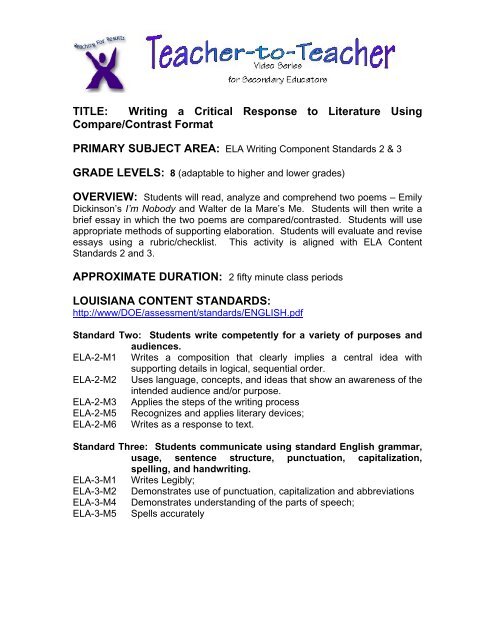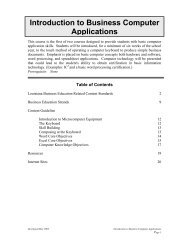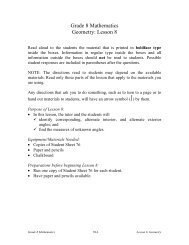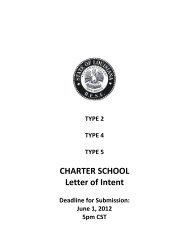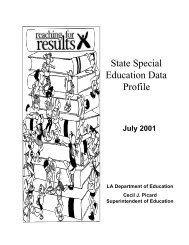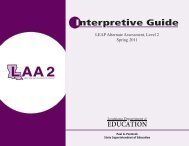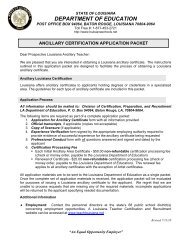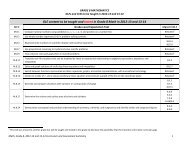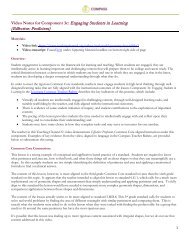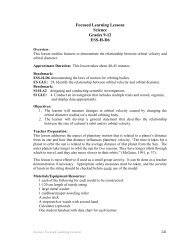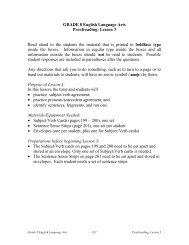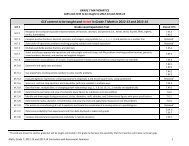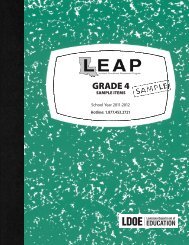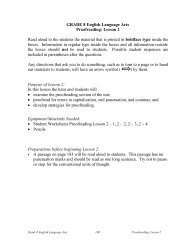TITLE: Writing a Critical Response to Literature Using Compare ...
TITLE: Writing a Critical Response to Literature Using Compare ...
TITLE: Writing a Critical Response to Literature Using Compare ...
You also want an ePaper? Increase the reach of your titles
YUMPU automatically turns print PDFs into web optimized ePapers that Google loves.
GLEs Addressed:Grade 815. Write complex, multiparagraph compositions on student- or teacherselected<strong>to</strong>pics organized with the following:• a clearly stated focus or central idea• important ideas or events stated in a selected order• organizational patterns (e.g., comparison/contrast, order ofimportance, chronological order) appropriate <strong>to</strong> the <strong>to</strong>pic• elaboration (anecdotes, relevant facts, examples, and/or specificdetails)• transitional words and phrases that unify ideas and points• an overall structure (e.g., introduction, body/middle, and concludingparagraph that summarizes important ideas and details) (ELA-2-M1)16. Organize individual paragraphs with <strong>to</strong>pic sentences, relevant elaboration,and concluding sentences (ELA-2-M1)17. Develop grade-appropriate compositions on student- or teacher-selected<strong>to</strong>pics that include the following:• word choices (diction) appropriate <strong>to</strong> the identified audience and/orpurpose• vocabulary selected <strong>to</strong> clarify meaning, create images, and set a<strong>to</strong>ne• information/ideas selected <strong>to</strong> engage the interest of the reader• clear voice (individual personality)• variety in sentence structure (ELA-2-M2)18. Develop grade-appropriate compositions by identifying and applying writingprocesses such as the following:• selecting <strong>to</strong>pic and form• prewriting (e.g., brains<strong>to</strong>rming, researching, raising questions,generating graphic organizers)• drafting• conferencing (e.g., peer and teacher)• revising based on feedback and use of various <strong>to</strong>ols (e.g., LEAP21Writer’s Checklist, rubrics)• proofreading/editing• publishing using technology (ELA-2-M3)21. Develop writing using a variety of literary devices, includingunderstatements and allusions (ELA-2-M5)22. Write for a wide variety of purposes, including:• persuasive letters that include appropriate wording and <strong>to</strong>ne andthat state an opinion• evaluations of advertisements, political car<strong>to</strong>ons, and speeches• text-supported interpretations of elements of grade-appropriates<strong>to</strong>ries, poems, plays, and novels (ELA-2-M6)23. Use standard English capitalization and punctuation consistently(ELA-3-M2)25. Apply knowledge of parts of speech in writing, including:• infinitives, participles, and gerunds
• superlative and comparative degrees of adjectives• adverbs (ELA-3-M4)26. Spell high-frequency, commonly confused, frequently misspelled wordsand derivatives (e.g., roots and affixes) correctly (ELA-3-M5)27. Use a variety of resources (e.g., glossaries, dictionaries, thesauruses, spellcheck) <strong>to</strong> find correct spellings (ELA-3-M5)TECHNOLOGY STRATEGIES:http://www.louisianaschools.net/DOE/LCET/curric/k12stand.pdfTechnology Communication Tools (Communication Foundation Skill)Students use telecommunications <strong>to</strong> collaborate, publish, and interact withpeers, experts and other audiences.Technology Productivity Tools (Resource Access and UtilizationFoundation Skill)Students use technology <strong>to</strong>ols <strong>to</strong> enhance learning, increase productivity,and promote creativity.Technology Research Tools (Linking and Generating KnowledgeFoundation Skill)Students use appropriate technology <strong>to</strong> locate, evaluate, and collectinformation from a variety of sources.Students use technology <strong>to</strong>ols <strong>to</strong> process data and report results.Students evaluate and select new information resources and technologicalinnovations based on the appropriateness <strong>to</strong> specific tasks.Social, Ethical, and Human Issues (Citizenship Foundation Skill)Students understand the ethical, cultural, and societal issues related <strong>to</strong>technology.Students practice responsible use of technology systems, information, andsoftware.Students develop positive attitudes <strong>to</strong>ward technology uses that supportlifelong learning, collaboration, personal pursuits, and productivity.INTERDISCIPLINARY CONNECTIONS:Geography: Physical and Cultural Systems, His<strong>to</strong>ry: Time, Continuity, andChangeOBJECTIVES:1. The learner will identify the speaker and speaker’s perspective in apoem.2. The learner will write a critical response that compares/contrastspoetry.3. The learner will use evidence from the text <strong>to</strong> support a response.4. The learner will use a rubric for self-evaluation and revision.
HOW TO ORGANIZE A COMPARISON-CONTRAST ESSAYIn a comparison-contrast essay, you can either• compare and contrast each subject separately or• discuss each similarity and difference between each subject pointby point.Here are two examples:SUBJECT-BY-SUBJECT ORGANIZATIONIn the following model, <strong>to</strong>pics are compared and contrasted by firstdiscussing the details of one subject and then the other.The main ingredient in a frittata is eggs. Cheese, vegetables, andpota<strong>to</strong>es may be added. A frittata is cooked in a frying pan over Low heatfor a long time. It is not folded before serving.Eggs are also the main ingredient in an omelette. Although cheese andvegetables may be added, pota<strong>to</strong>es usually are not. An omelette is cooked ina frying pan over high heat for a short period of time. Just before beingremoved from the pan, it is folded over.POINT-BY-POINT ORGANIZATIONThe following model moves back and forth between two subjects, comparingand contrasting the subjects point by point.In both frittatas and omelettes, the main ingredient is eggs. Cheeseand vegetables are often added <strong>to</strong> omelettes and frittatas. However,pota<strong>to</strong>es are usually added only <strong>to</strong> frittatas.Both omelettes and frittatas are cooked in a frying pan. However,frittatas are cooked for a long period of time over low heat, whereasomelettes are cooked quickly over high heat. Omelettes are folded in thepan before being served, but frittatas are not.
I’m NobodyEmily DickinsonI’m Nobody! Who are you?Are you—Nobody—<strong>to</strong>o?Then there’s a pair of us!Don’t tell! They’d banish us—you know!How dreary—<strong>to</strong> be—Somebody!How public—like a Frog—To tell your name—the livelong June—To an admiring Bog!MeWalter de la MareAs long as I liveI shall always beMy self—and no other.Just me.Like a tree.Like a willow or elder,An aspen, a thorn,Or a cypress forlorn.Like a flower,For its hourA primrose, a pink,Or a violet—Sunned by the sun,And with dewdrops wet.Always just me.Source: Prentice-Hall, Inc.
<strong>Compare</strong>/Contrast Essay<strong>Compare</strong> means <strong>to</strong> point out similarities. Contrast means <strong>to</strong> point outdifferences. Often in literary response you are asked <strong>to</strong> compare andcontrast two characters or two other related subjects. This helps you <strong>to</strong>understand each of them better.A successful comparison/contrast essay should:• introduce the subjects being compared• state a clear purpose for the comparison• include both similarities and differences and support each statementwith examples and details• follow a clear organizational pattern• include transitional words and phrases <strong>to</strong> make similarities anddifferences clear• summarize the comparison in the conclusionAn essay should have these three parts:Introduction – introduces the subjects being compared and tells thereason for the comparisonBody – explains similarities and differencesConclusion – summarizes the comparison and explains newunderstandingTransitional Words:Words that show similarities: also, both, similarly, like, in addition, <strong>to</strong>o,another, just as, in the same wayWords that show differences: but, although, however, yet, still, instead,unlike, in contrast, is spite of, on the other hand
Comparing and Contrasting Poems<strong>Writing</strong> AssignmentWrite a brief essay in which you compare two poems. Write at leastthree paragraphs.BackgroundWhen you compare two poems (or s<strong>to</strong>ries or plays), you tell how theyare alike. When you contrast two works, you point out the ways in whichthey are different. Poems can be compared and contrasted if they have atleast one thing in common—a similar subject, perhaps, or similar imagesor figures of speech or ideas. You can recognize similarities anddifferences by focusing on the elements in each poem.PrewritingReread both poems, and fill in a chart such as the one that follows.When you’ve completed your chart, indicate in some way the similaritiesand differences. You can put a + sign next <strong>to</strong> things the poems have incommon, and a 0 next <strong>to</strong> the things that are different. Or you can usehighlighters <strong>to</strong> color code similarities and differences. You could mark thesimilarities with pink, for example, and the differences with yellow.Your last Prewriting step is <strong>to</strong> make two lists summarizing thesimilarities and differences.SimilaritiesDifferences1. 1.2. 2.3. 3.<strong>Writing</strong>Follow this plan in organizing your essay:Paragraph 1: Mention the titles and authors of the poems. Tell about atleast two similarities. Cite lines from the poems.Paragraph 2: Tell about at least two differences.Paragraph 3: Restate your main ideas about the poems’ similarities anddifferences.
Elements of PoetrySubject (What is the poemabout?)TitleTitleTheme (What does thepoem say about thesubjects?)Figures of Speech (Doesthe poet use similes,metaphors, orpersonifications?)Sound (Does the poet userhyme, meter, alliteration?)Tone (Is the poem serious,humorous, mocking,mournful?)
Revising and Proofreading Self-Evaluation Guide1. Does the first paragraph mention both poems’ titles andauthors?2. Have I discussed two or three similarities in the first paragraphtwo or three differences in the second paragraph?3. Have I summarized my ideas in the third paragraph?4. Does every sentence start with a capital letter and end with aperiod or other end punctuation mark?5. Are my ideas clearly expressed? Have I said everything Iwant<strong>to</strong> say?6. Do I have any spelling errors?7. Did I use transitional words and phrases?*********************************************************************Peer EvaluationYesNo1. Are there any spelling errors?Yes NoComments2. Are the sentences punctuatedcorrectly?3. Are the paragraphs fully developed (atleast five sentences long) and indented?4. Are any sentences unclear? Do I understandwhat you are trying <strong>to</strong> say?5. What do I like best about this paper?6. What do I think needs improvement?
TitleNameDatePeriod<strong>Compare</strong>/Contrast EssayRubric1. Opening catches reader’s interest 0 1 2 3 42. Introduces the subjects being compared 0 1 2 3 41. State a clear purpose for the comparison 0 1 2 3 42. Includes both similarities and differences 0 1 2 3 4and supports each statement with examplesand details3. Follows a clear organizational pattern 0 1 2 3 44. Includes transitional words and phrases 0 1 2 3 4<strong>to</strong> make similarities and differences clear5. Summarizes the comparison in the conclusion 0 1 2 3 46. Uses correct grammar 0 1 2 3 47. Uses correct spelling 0 1 2 3 48. Uses correct capitalization and punctuation 0 1 2 3 4Total______x 2.5Grade_____
Title_________________________ Name_________________________Date_________________________<strong>Response</strong> <strong>to</strong> <strong>Literature</strong><strong>Writing</strong> Standard 2If you use a number scale, divide the number of points earned by thenumber of traits.Write responses <strong>to</strong> literature that0 = not evident1 =minimal evidence of mastery2 = adequate evidence of mastery3 = strong evidence of mastery4 = outstanding evidence of mastery_____Advance a judgment that demonstrates a comprehensive grasp of thesignificant ideas of works or passages._____Support key ideas and viewpoints through accurate and detailedreferences <strong>to</strong> the text or <strong>to</strong> other works._____Demonstrate awareness of the author’s use of stylistic devices andan appreciation of the effects created._____Identify and assess the impact of perceived ambiguities, nuances,and complexities within text.


